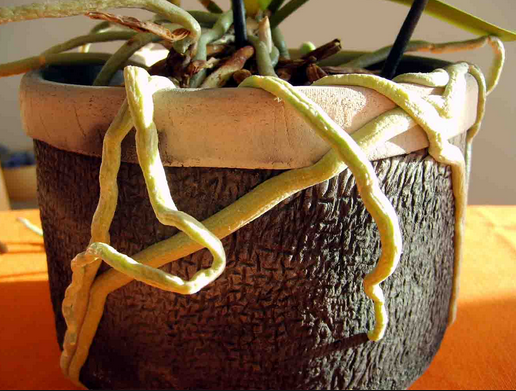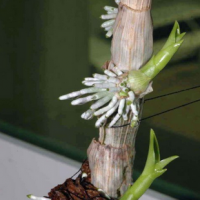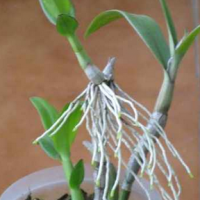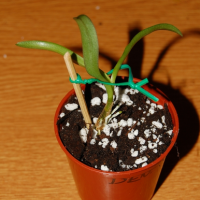+ Spanish
As we said before, 80% of orchid species are epiphyte which means they grow on trees or bushes. They are not parasites, contrary of what many people think, they don’t “steel” anything from the trees they live on, they just use them for support. Their roots are think and are covered by a layer of dead cells called velamen; this layer acts like a sponge and absorbs the relative humidity in the air. The photosynthesis process takes place in the roots with the help of the sun; they also get the nutrients they need through the roots from the water that pours down the trees collecting minerals and organic matter.
When we take an orchid out of it’s natural habitat to be planted in a pot inside our homes, they’ll try to adapt as much as possible. This is why sometimes, when the plant is adapted to this new environment and the new growths begin, some orchids develop aerial roots. This are roots that grow from the crown, outside of the media the orchid is potted in. Their function is to absorb humidity and micronutrients floating in the atmosphere.
What to do about aerial roots?
Since inside most of our homes those micronutrients do not existe and a big part of our orchid’s health relays on the feeding we give it through fertilizers, these roots’ function is secondary; the roots that are the most important in the development of the orchids are the ones inside the media where they are getting water and nutrients constantly. When you water and fertilize, don’t forget about this aerial roots! You can spray them with the same solution you’re using to water the orchid up to the base of the plant (don’t soak the pot deeper to cover these air roots, you could rot the crown).
Another issue for these roots inside our homes, is the insufficient relative humidity. It’s common that the air roots dry up faster because they are not getting enough humidity from the air; it’s important to increase your RH levels!! See “tips to increase RH“.
Aesthetically, they may not be as pleasing to the eye, but even if secondary, they still have an important function!! Do not cut them off, unless they are already dry; as usual, please use disinfected tools and cauterize.
Aerial root types:
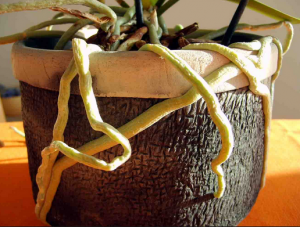 We have those that grow near the base of the plant and are easier to handle and rearrange like the Phalaenopsis roots by repotting; and then we have those that grow from a higher point between the leaves, like in Vandas. Also, if you’re lucky, from the stems that have finished their flowering period, you may get a keiki, and then you’ll have aerial roots as well, far far away from the growing media.
We have those that grow near the base of the plant and are easier to handle and rearrange like the Phalaenopsis roots by repotting; and then we have those that grow from a higher point between the leaves, like in Vandas. Also, if you’re lucky, from the stems that have finished their flowering period, you may get a keiki, and then you’ll have aerial roots as well, far far away from the growing media.
With the first ones, what we recommend is to repot your orchid when this roots are about 1.5″ long; first, while repotting, make sure to accommodate these aerial roots inside the media. If the roots are longer and older, soak them in luke warm water for half an hour to make them softer and more malleable. Ne careful not to break them placing them gently inside the pot. If you have doubts, check out our article “How to know if it’s time to repot?”
Now, if the roots are growing between the leaves, you need to procure good hydration.
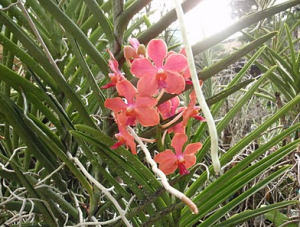
If you’re lucky enough to have a keiki growing from your orchid, you need to take care of it’s roots too!! Fertilize and procure a very good level of RH until the keiki is big enough and ready to be separated from the mother and repotted in it’s own pot. It’s really important that you make sure your keiki has developed a strong root system before cutting it off for it to be able to survive on it’s own. Make sure you have 3 or 4 roots at least 1.5″ long each. Repot in a small pot, preferably with Sphagnum moss, and place the little one near the mother’s pot; the mother will help the baby because the RH around it will be higher and also, for the baby to live in the same environment as it used to (light, temperature, air movement…).

